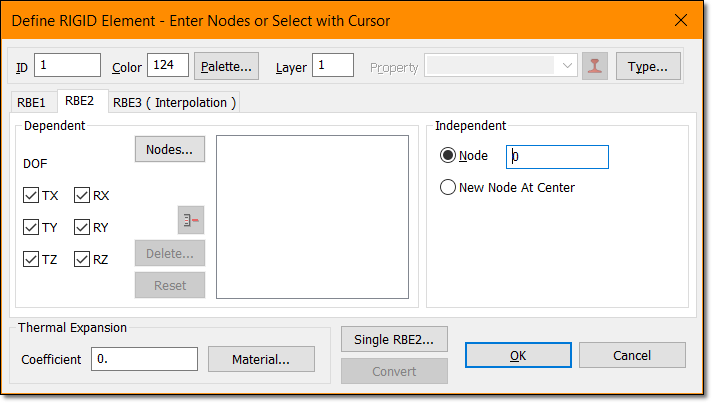Not sure what the mechanism is, but here is a way to model fixed or free rotation/translation: (whichever you need)
[ol 1]
[li]Connect all edge most diameter nodes to an RBE2 element (spider RBE2). The dependent (single set) node of your RBE2 should be at the center of that hole.[/li]
[li]At this dependent node, create a "coincident" node CBUSH element. One of the nodes of your CBUSH element will be this dependent node of your RBE2 element.[/li]
[li]Connect your 2nd node of the CBUSH element to the interface PART/ELEMENT. (Let's say if one of your parts is a tube modeled with shell elements, and the other part is a shell mesh part with a lug hole in it - where the tube will pass through- then you will have 2 separate RBE2 elements. One of them will be for the tube, the other one will be for the part with the lug hole. The 2 RBE2 elements' center (dependent) nodes will be coincident at the rotation axis. And your 1st CBUSH element node will be connected to one of these RBE2 center nodes; and your 2nd CBUSH element node will be connected to the other RBE2 center node)[/li]
[li]After you have 2 nodes of your CBUSH connected to the different interface parts, you can define the CBUSH stiffnesses (K1, K2, K3, K4, K5, K6 in the Nastran CBUSH Card) per your needs. (Let's say if you have free rotation on Z-axis, you can define a K6 value of 1 or 10. But if you have fixed rotation on Z-axis, then you can defined a K6 value of 1E10 or 10^10).[/li]
[li]Depending on the orientation of your CBUSH element, you can either define a separate coordinate system for your CBUSH, or if your rotational/translational axes are perfectly aligned with your Global Coordinate System, you might as well just use the Global Coordinate System to assign your K1, K2, K3, K4, K5, K6 stiffness values).[/li]
[/ol]
Just as a warning, "not assigning a K value in any rotational degree of freedom sometimes may lead to diagonal matrix errors due to singularities, so I would first suggest using dummy K values like 1 or 10 for free rotational DOFs.
Spaceship!!
Aerospace Engineer, M.Sc. / Aircraft Stress Engineer with 7 years of experience
(United States)

